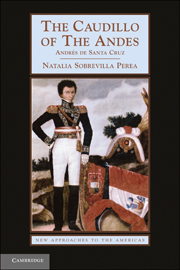Book contents
- Frontmatter
- Contents
- List of Maps and Illustrations
- Timeline for Santa Cruz
- Acknowledgments
- Introduction
- 1 Early Years at the Twilight of the Colonial Period
- 2 Great Marshall of Zepita
- 3 The Creation of Bolivia
- 4 The Genesis of the Peru-Bolivia Confederation
- 5 The Rise and Fall of the Peru-Bolivia Confederation
- 6 Defeat and Exile
- Epilogue: The Long-Term Consequences of the Fall of the Confederation
- Bibliography
- Index
3 - The Creation of Bolivia
Published online by Cambridge University Press: 05 June 2012
- Frontmatter
- Contents
- List of Maps and Illustrations
- Timeline for Santa Cruz
- Acknowledgments
- Introduction
- 1 Early Years at the Twilight of the Colonial Period
- 2 Great Marshall of Zepita
- 3 The Creation of Bolivia
- 4 The Genesis of the Peru-Bolivia Confederation
- 5 The Rise and Fall of the Peru-Bolivia Confederation
- 6 Defeat and Exile
- Epilogue: The Long-Term Consequences of the Fall of the Confederation
- Bibliography
- Index
Summary
With the defeat of the royalist forces in Peru, the wars of independence in continental Spanish America were nearly over. Only the Upper Peruvian provinces remained in the hands of men who continued to recognize the king in Spain as the legitimate authority. The area that, as early as 1809, declared it did not want to be under the control of Buenos Aires or Lima and had sought to establish autonomous Juntas in Chuquisaca and La Paz was still in 1825 asserting its desire to be independent from the two former viceregal capitals. Although both were the centers of new independent republics, the provinces of the Audiencia of Charcas still wanted to remain separate from them. One way to achieve this was to maintain their links to the peninsula.
This chapter begins by looking at the process by which Bolivia came into being and the role Colombians, who were outsiders, played in finding a solution. The situation was so complicated that even they had different views on whether to create a new republic or not. Sucre and Bolívar did not agree on how to decide the future of these territories. There were two main principles used to settle this issue. Sucre favored “free determination of the people” – giving local populations the right to choose – whereas Bolívar was inclined toward uti possidetis, the principle under which viceregal boundaries were to be respected.
- Type
- Chapter
- Information
- The Caudillo of the AndesAndrés de Santa Cruz, pp. 84 - 113Publisher: Cambridge University PressPrint publication year: 2011



